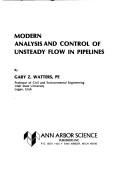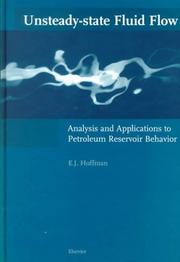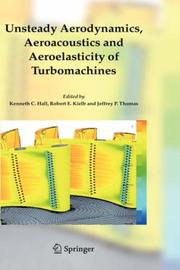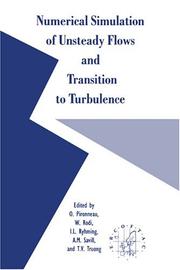| Listing 1 - 10 of 11 | << page >> |
Sort by
|
Book
ISBN: 1281728667 9786611728663 2759801101 9782759801107 Year: 2007 Publisher: Les Ulis, France : EDP Sciences,
Abstract | Keywords | Export | Availability | Bookmark
 Loading...
Loading...Choose an application
- Reference Manager
- EndNote
- RefWorks (Direct export to RefWorks)
This work focuses on fluid mechanics, in particular hydrodynamic instabilities – a particularly important theory for study of transition flow.
Unsteady flow (Fluid dynamics) --- Flow, Pulsating (Fluid dynamics) --- Flow, Transient (Fluid dynamics) --- Flow, Unsteady (Fluid dynamics) --- Fluid transients (Fluid dynamics) --- Pulsating flow (Fluid dynamics) --- Transient flow (Fluid dynamics) --- Transients, Fluid (Fluid dynamics) --- Unsteady fluid dynamics --- Fluid dynamics

ISBN: 0250402289 Year: 1979 Publisher: Ann Arbor (Mich.) : Ann Arbor science,
Abstract | Keywords | Export | Availability | Bookmark
 Loading...
Loading...Choose an application
- Reference Manager
- EndNote
- RefWorks (Direct export to RefWorks)
#ABIB:irri --- Pipe --- Unsteady flow (Fluid dynamics) --- Fluid dynamics. --- Unsteady flow (Fluid dynamics). --- Flow, Pulsating (Fluid dynamics) --- Flow, Transient (Fluid dynamics) --- Flow, Unsteady (Fluid dynamics) --- Fluid transients (Fluid dynamics) --- Pulsating flow (Fluid dynamics) --- Transient flow (Fluid dynamics) --- Transients, Fluid (Fluid dynamics) --- Unsteady fluid dynamics --- Fluid dynamics
Book
ISBN: 1282769146 9786612769146 008093174X 0444529535 9780444529534 9780080931746 Year: 2010 Publisher: Amsterdam ; London : Elsevier Science,
Abstract | Keywords | Export | Availability | Bookmark
 Loading...
Loading...Choose an application
- Reference Manager
- EndNote
- RefWorks (Direct export to RefWorks)
This reference presents a comprehensive description of flow through porous media and solutions to pressure diffusion problems in homogenous, layered, and heterogeneous reservoirs. It covers the fundamentals of interpretation techniques for formation tester pressure gradients, and pretests, multiprobe and packer pressure transient tests, including derivative, convolution, and pressure-rate and pressure-pressure deconvolution. Emphasis is placed on the maximum likelihood method that enables one to estimate error variances in pressure data along with the unknown formation parameters.<
Hydrocarbon reservoirs --- Porous materials --- Unsteady flow (Fluid dynamics) --- Testing. --- Permeability. --- Flow, Pulsating (Fluid dynamics) --- Flow, Transient (Fluid dynamics) --- Flow, Unsteady (Fluid dynamics) --- Fluid transients (Fluid dynamics) --- Pulsating flow (Fluid dynamics) --- Transient flow (Fluid dynamics) --- Transients, Fluid (Fluid dynamics) --- Unsteady fluid dynamics --- Fluid dynamics --- Porous media --- Materials --- Porosity --- Reservoirs, Hydrocarbon --- Traps (Petroleum geology)
Book
ISBN: 9781783266609 1783266600 9781783266616 1783266619 9781783266623 1783266627 9781783266630 1783266635 Year: 2016 Publisher: London : Imperial College Press,
Abstract | Keywords | Export | Availability | Bookmark
 Loading...
Loading...Choose an application
- Reference Manager
- EndNote
- RefWorks (Direct export to RefWorks)
"This book is intended for self-study or as a companion of lectures delivered to post-graduate students on the subject of the computational prediction of complex turbulent flows. There are several books in the extensive literature on turbulence that deal, in statistical terms, with the phenomenon itself, as well its many manifestations in the context of fluid dynamics. Statistical Turbulence Modelling for Fluid Dynamics — Demystified differs from these and focuses on the physical interpretation of a broad range of mathematical models used to represent the time-averaged effects of turbulence in computational prediction schemes for fluid flow and related transport processes in engineering and the natural environment. It dispenses with complex mathematical manipulations and instead gives physical and phenomenological explanations. This approach allows students to gain a 'feel' for the physical fabric represented by the mathematical structure that describes the effects of turbulence and the models embedded in most of the software currently used in practical fluid-flow predictions, thus counteracting the ill-informed black-box approach to turbulence modelling. This is done by taking readers through the physical arguments underpinning exact concepts, the rationale of approximations of processes that cannot be retained in their exact form, and essential calibration steps to which the resulting models are subjected by reference to theoretically established behaviour of, and experimental data for, key canonical flows."--
Eddies. --- Fluid dynamics --- Turbulence --- Unsteady flow (Fluid dynamics) --- Mathematical models. --- Water currents --- Whirlpools --- Flow, Pulsating (Fluid dynamics) --- Flow, Transient (Fluid dynamics) --- Flow, Unsteady (Fluid dynamics) --- Fluid transients (Fluid dynamics) --- Pulsating flow (Fluid dynamics) --- Transient flow (Fluid dynamics) --- Transients, Fluid (Fluid dynamics) --- Unsteady fluid dynamics
Book
ISBN: 0323911137 0323911129 9780323911139 9780323911122 Year: 2021 Publisher: Cambridge, Massachusetts ; Oxford, England : Gulf Professional Publishing,
Abstract | Keywords | Export | Availability | Bookmark
 Loading...
Loading...Choose an application
- Reference Manager
- EndNote
- RefWorks (Direct export to RefWorks)
Geotechnical engineering --- Unsteady flow (Fluid dynamics) --- Data processing. --- Mathematical models. --- Flow, Pulsating (Fluid dynamics) --- Flow, Transient (Fluid dynamics) --- Flow, Unsteady (Fluid dynamics) --- Fluid transients (Fluid dynamics) --- Pulsating flow (Fluid dynamics) --- Transient flow (Fluid dynamics) --- Transients, Fluid (Fluid dynamics) --- Unsteady fluid dynamics --- Fluid dynamics --- Engineering, Geotechnical --- Geotechnics --- Geotechnology --- Engineering geology

ISBN: 9780444501844 0444501843 9780080543451 0080543456 1281018996 9781281018991 9786611018993 6611018999 Year: 1999 Publisher: Amsterdam New York Elsevier
Abstract | Keywords | Export | Availability | Bookmark
 Loading...
Loading...Choose an application
- Reference Manager
- EndNote
- RefWorks (Direct export to RefWorks)
The ubiquitous examples of unsteady-state fluid flow pertain to the production or depletion of oil and gas reservoirs. After introductory information about petroleum-bearing formations and fields, reservoirs, and geologic codes, empirical methods for correlating and predicting unsteady-state behavior are presented. This is followed by a more theoretical presentation based on the classical partial differential equations for flow through porous media. Whereas these equations can be simplified for the flow of (compressible) fluids, and idealized solutions exist in terms of Fourier series fo
Unsteady flow (Fluid dynamics) --- Petroleum engineering. --- Mining engineering --- Flow, Pulsating (Fluid dynamics) --- Flow, Transient (Fluid dynamics) --- Flow, Unsteady (Fluid dynamics) --- Fluid transients (Fluid dynamics) --- Pulsating flow (Fluid dynamics) --- Transient flow (Fluid dynamics) --- Transients, Fluid (Fluid dynamics) --- Unsteady fluid dynamics --- Fluid dynamics

ISBN: 1281103233 9786611103231 1402046057 1402042671 9048170915 9781402042676 Year: 2006 Publisher: Dordrecht : Springer,
Abstract | Keywords | Export | Availability | Bookmark
 Loading...
Loading...Choose an application
- Reference Manager
- EndNote
- RefWorks (Direct export to RefWorks)
This textbook is a collection of technical papers that were presented at the 10th International Symposium on Unsteady Aerodynamics, Aeroacoustics, and Aeroelasticity of Turbomachines held September 8-11, 2003 at Duke University in Durham, North Carolina. The papers represent the latest in state of the art research in the areas of aeroacoustics, aerothermodynamics, computational methods, experimental testing related to flow instabilities, flutter, forced response, multistage, and rotor-stator effects for turbomachinery.
Turbomachines --- Unsteady flow (Fluid dynamics) --- Aerodynamics. --- Flow, Pulsating (Fluid dynamics) --- Flow, Transient (Fluid dynamics) --- Flow, Unsteady (Fluid dynamics) --- Fluid transients (Fluid dynamics) --- Pulsating flow (Fluid dynamics) --- Transient flow (Fluid dynamics) --- Transients, Fluid (Fluid dynamics) --- Unsteady fluid dynamics --- Fluid dynamics --- Aerodynamics --- Mechanical engineering. --- Engineering. --- Mechanical Engineering. --- Automotive Engineering. --- Engineering, general. --- Machinery and Machine Elements. --- Construction --- Industrial arts --- Technology --- Engineering, Mechanical --- Engineering --- Machinery --- Steam engineering --- Automotive engineering. --- Machinery. --- Machines --- Manufactures --- Power (Mechanics) --- Mechanical engineering --- Motors --- Power transmission --- Curious devices
Book
ISBN: 9811985782 9811985774 Year: 2023 Publisher: Singapore : Springer Nature Singapore : Imprint: Springer,
Abstract | Keywords | Export | Availability | Bookmark
 Loading...
Loading...Choose an application
- Reference Manager
- EndNote
- RefWorks (Direct export to RefWorks)
This book discusses various passive and active techniques for controlling unsteady flow dynamics and associated coupled mechanics of fluid-structure interaction. Coupled multiphysics and multidomain simulations are emerging and challenging research areas, which have received significant attention during the past decade. One of the most common multiphysics and multidomain problems is fluid-structure interaction (FSI), i.e., the study of coupled physical systems involving fluid and a structure that have a mechanical influence on each other. Regardless of the application area, the investigation toward modeling of fluid-structure interaction and the underlying mechanisms in dealing with coupled fluid-structure instability with real-world applications remains a challenge to scientists and engineers. This book is designed for students and researchers who seek knowledge of computational modeling and control strategies for fluid-structure interaction. Specifically, this book provides a comprehensive review of the underlying unsteady physics and coupled mechanical aspects of the fluid-structure interaction of freely vibrating bluff bodies, the self-induced flapping of thin flexible structures, and aeroelasticity of shell structures. Understanding flow-induced loads and vibrations can lead to safer and cost-effective structures, especially for light and high-aspect ratio structures with increased flexibility and harsh environmental conditions. Using the body-fitted and moving mesh formulations, the physical insights associated with structure-to-fluid mass ratios, Reynolds number, nonlinear structural deformation, proximity interference, near-wall contacts, free-surface, and other interacting physical fields are covered in this book. In conjunction with the control techniques, data-driven model reduction approaches based on subspace projection and deep neural calculus are covered for low-dimensional modeling of unsteady fluid-structure interaction.
Unsteady flow (Fluid dynamics) --- Fluid-structure interaction. --- Structure-fluid interaction --- Fluid dynamics --- Structural dynamics --- Flow, Pulsating (Fluid dynamics) --- Flow, Transient (Fluid dynamics) --- Flow, Unsteady (Fluid dynamics) --- Fluid transients (Fluid dynamics) --- Pulsating flow (Fluid dynamics) --- Transient flow (Fluid dynamics) --- Transients, Fluid (Fluid dynamics) --- Unsteady fluid dynamics --- Fluid mechanics. --- Engineering mathematics. --- Engineering—Data processing. --- Mathematical physics. --- Numerical analysis. --- Mechanics, Applied. --- Solids. --- Physics. --- Engineering Fluid Dynamics. --- Mathematical and Computational Engineering Applications. --- Theoretical, Mathematical and Computational Physics. --- Numerical Analysis. --- Solid Mechanics. --- Classical and Continuum Physics. --- Physical mathematics --- Physics --- Mathematics --- Engineering --- Engineering analysis --- Mathematical analysis --- Hydromechanics --- Continuum mechanics --- Natural philosophy --- Philosophy, Natural --- Physical sciences --- Dynamics --- Solid state physics --- Transparent solids --- Applied mechanics --- Engineering, Mechanical --- Engineering mathematics
Book
ISBN: 1402098979 9786612510472 1282510479 1402098987 Year: 2009 Publisher: Dordrecht ; New York : Springer,
Abstract | Keywords | Export | Availability | Bookmark
 Loading...
Loading...Choose an application
- Reference Manager
- EndNote
- RefWorks (Direct export to RefWorks)
Unsteady separated flows are an important topic in theoretical and applied mechanics. The IUTAM Symposium held in Corfu in 2007 (and following on from a previous meeting in Toulouse in 2002) aimed at achieving a unified approach which will regroup the knowledge coming from theoretical, experimental, numerical simulation, modeling and flow-control aspects of separated unsteady flows with respect to incompressible and compressible flow regimes. The subject areas are receiving a great deal of impetus from international research groups, stimulated by major research programs related to this topic, involving major industrial companies especially in aeronautics in various countries and by heading government programs. The symposium brought together groups of researchers working on problems related to the understanding and the prediction of unsteady, separated flows. The present IUTAM symposium proceedings volume is an essential extension of the topic to control theory and applications in respect of unsteady separated flows. Topics addressed include physical aspects of the dynamics related to unsteady separation in incompressible flows and flows under compressibility effects, and the state of the art methods for modeling these kinds of flows in high Reynolds numbers. Special attention is paid to control theory and applications, especially including feed-back effects for the attenuation of unsteadiness and of flow separation. The understanding of the flow-physics and their efficient turbulence modeling remains a serious problem in a number of engineering applications, including Aeronautics and Aeroelasticity. Furthermore, the study of advanced flow modeling techniques, especially to control high-Reynolds number transitional and turbulent flows involving unsteady separation, is a crucial need in the above-mentioned domains of fundamental and applied research nowadays. This work is of interest to people working in experimental investigation of unsteady separated flows, those working in the numerical simulation and turbulence modeling of these flows and those working in the domain of control theory. The symposium proceedings contributes to a better insight of this important category of flows from a fundamental and applied research point of view by means of a synergy among the three main approaches: theoretical, experimental and prediction methods.
Turbulence -- Mathematical models -- Congresses. --- Unsteady flow (Aerodynamics) -- Mathematical models -- Congresses. --- Unsteady flow (Fluid dynamics) -- Mathematical models -- Congresses. --- Physics - General --- Civil Engineering --- Civil & Environmental Engineering --- Physics --- Engineering & Applied Sciences --- Physical Sciences & Mathematics --- Unsteady flow (Fluid dynamics) --- Fluid dynamics. --- Flow, Pulsating (Fluid dynamics) --- Flow, Transient (Fluid dynamics) --- Flow, Unsteady (Fluid dynamics) --- Fluid transients (Fluid dynamics) --- Pulsating flow (Fluid dynamics) --- Transient flow (Fluid dynamics) --- Transients, Fluid (Fluid dynamics) --- Unsteady fluid dynamics --- Physics. --- Computer mathematics. --- Continuum physics. --- Fluids. --- Physical measurements. --- Measurement. --- Classical Continuum Physics. --- Computational Science and Engineering. --- Physics, general. --- Measurement Science and Instrumentation. --- Fluid- and Aerodynamics. --- Fluid dynamics --- Dynamics --- Fluid mechanics --- Computer science. --- Classical and Continuum Physics. --- Natural philosophy --- Philosophy, Natural --- Physical sciences --- Informatics --- Science --- Measurement . --- Hydraulics --- Mechanics --- Hydrostatics --- Permeability --- Measuring --- Mensuration --- Mathematics --- Technology --- Metrology --- Physical measurements --- Measurements, Physical --- Mathematical physics --- Measurement --- Computer mathematics --- Electronic data processing --- Classical field theory --- Continuum physics --- Continuum mechanics

ISBN: 0521416183 Year: 1992 Publisher: Cambridge Cambridge University press
Abstract | Keywords | Export | Availability | Bookmark
 Loading...
Loading...Choose an application
- Reference Manager
- EndNote
- RefWorks (Direct export to RefWorks)
519.876.5 --- Turbulence --- -Unsteady flow (Fluid dynamics) --- -519.6 --- 681.3 *G18 --- 681.3*I6 --- Flow, Pulsating (Fluid dynamics) --- Flow, Transient (Fluid dynamics) --- Flow, Unsteady (Fluid dynamics) --- Fluid transients (Fluid dynamics) --- Pulsating flow (Fluid dynamics) --- Transient flow (Fluid dynamics) --- Transients, Fluid (Fluid dynamics) --- Unsteady fluid dynamics --- Fluid dynamics --- Flow, Turbulent --- Turbulent flow --- Numerical imitation of systems. Simulation --- Mathematical models --- -Congresses --- Computational mathematics. Numerical analysis. Computer programming --- Partial differential equations: difference methods; elliptic equations; finite element methods; hyperbolic equations; method of lines; parabolic equations (Numerical analysis) --- Simulation and modeling (Computing methodologies)--See also {681.3*G3} --- Unsteady flow (Fluid dynamics) --- Congresses. --- 681.3*I6 Simulation and modeling (Computing methodologies)--See also {681.3*G3} --- 681.3 *G18 Partial differential equations: difference methods; elliptic equations; finite element methods; hyperbolic equations; method of lines; parabolic equations (Numerical analysis) --- 519.6 Computational mathematics. Numerical analysis. Computer programming --- 519.876.5 Numerical imitation of systems. Simulation --- 519.6 --- Mathematical models&delete& --- Congresses
| Listing 1 - 10 of 11 | << page >> |
Sort by
|

 Search
Search Feedback
Feedback About UniCat
About UniCat  Help
Help News
News